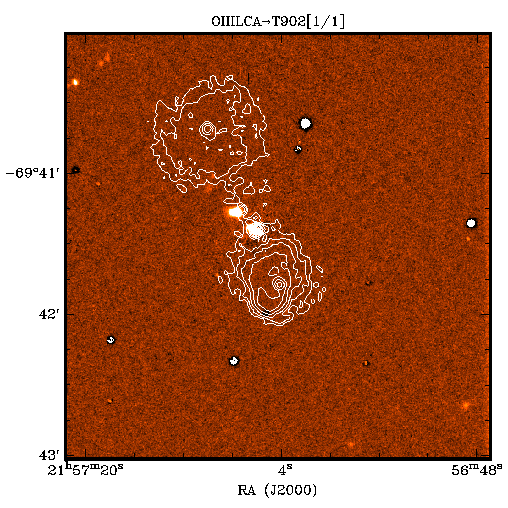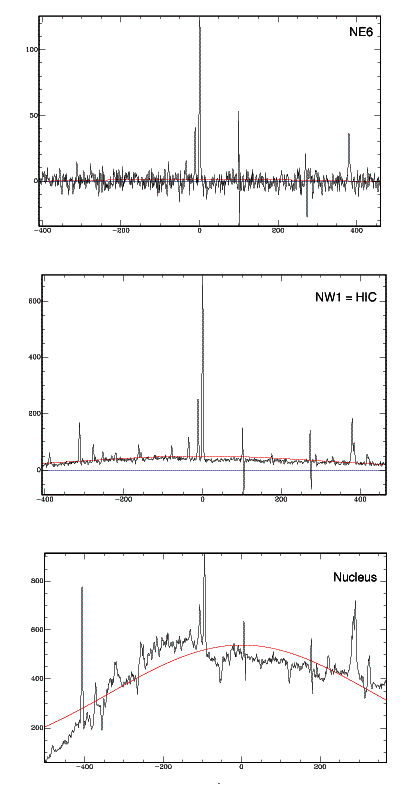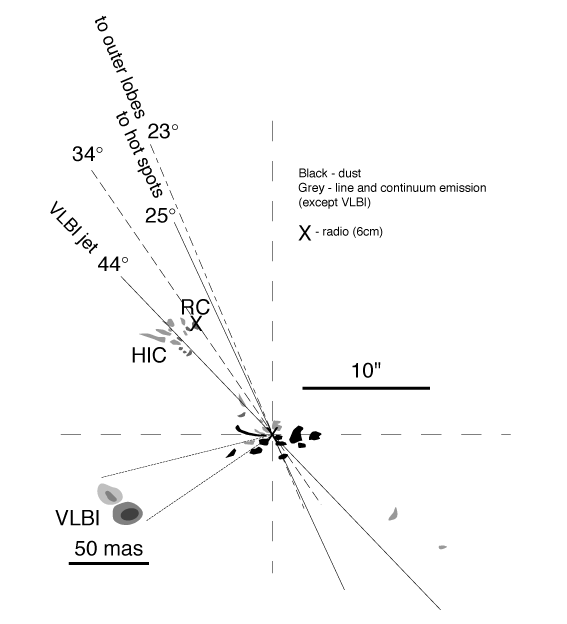Tom Oosterloo, Raffaella Morganti & Bob Fosbury
Abstract.Powerful radio galaxies are believed to contain AGN which are hidden from our direct view by a compact, optically thick nuclear structure. The AGN exhibit an axial symmetry which reveals itself both in the form of radio jets and associated lobes and the existence of co-aligned optical continuum and emission line structures (alignment effect refs). The latter are thought to result, at least partly, from the collimation of the AGN radiation field by processes ocurring in its viscinity.
The presence of 'ionization cones' in nearby AGN has been revealed by narrow-band emission line imaging (eg, Tsvetanov & Tadhunter). These are believed to result from shadows cast by the edges of a molecular torus on the parsec scale. The anisotropy which is produced by such shadowing is called 'extrinsic' and is to be contrasted with the property of 'intrinsic' beaming of radiation produced by the Doppler boosting of photon emission from material with a relativistic bulk motion. Evidence for the presence of such intrinsic beams comes from studies of BL Lac objects and Blazars (ref. to reviews) from gamma to radio energies. The optical and ultraviolet radiation in these beams might be expected to reveal itself - even when directed away from our line-of-sight - by scattering and line fluorescence processes when it interacts with dust and/or gas in the outer parts of galaxies.
When such beam-cloud interactions occur within the regions occupied by the radio jets themselves, it becomes difficult to distinguish those process which result from the jet particle beams from those which are caused by the relativistically collimated photons. The presence of highly excited gas clouds well beyond the radio emission in a classical double radio source provides, therefore, an important diagnostic of the photon radiation field from the AGN.
In this letter, we report optical narrow-band imaging and long-slit spectroscopic observations of regions up to a projected distance of 80kpc (H_0 = 50) from the nucleus of the z = 0.0282 radio galaxy PKS 2152-699. This source has been studied extensively at optical and radio wavelengths (list of refs) and is characterised by a very highly excited cloud (HIC) of gas at a projected distance of 8kpc along its radio axis. The cloud has a blue, polarized optical continuum which has been interpreted as Rayleigh scattering from small dust grains illuminated by beamed radiation from the AGN. We show that there are other less luminous but still highly excited clouds around the source close to the radio axis, in several cases, lying beyond the radio extent.
Narrow and broad-band imaging observations have been carried out of a ?' x ?' field centred on PKS 2152-699 with the ESO New Technology Telescope (NTT) and the EMMI imager/spectrograph. These observations have been blah-blah and a continuum subtracted [OIII] lambda 5007 image is shown in Fig. 1, overlayed with the ATCA radio contours from Fosbury et al. (1998). Refer to Table 1 -> imaging and spectroscopic observations.

Figure 1. A continuum-free [OIII] lambda 5007 line image of PKS 2152-699 overlayed with a 4.8GHz radio map from the Australia Telescope Compact Array (ATCA; Fosbury et al. 1998).
While the HIC and the two diffuse features close to the inner edge of the NE radio lobe (NE1-NE3) have been previously detected and studied, the more distant clouds were unknown. In order to confirm the line emitting nature of the brightest of these (approx. 1.5 arcmin to the NE), a long-slit spectrum was obtained with the EFOSC instrument on the ESO 3.6m telescope.
This spectrum has been wavelength and flux calibrated blah blah. In Fig. 2, we show spectral extractions for the nucleus, for the HIC and cloud NE6.

Figure 2. Optical spectra of the nucleus, the HIC (=NE1) and the distant cloud NE6. These have been normalised to the peak of the [OIII] lambda 5007 line. Note the similar ionization state ([OIII]/H-beta) of NE1 and NE6.
Objects on the continuum-free line image have been selected on the basis of their integrated flux density (discuss limiting value). Apparent sources which could arise from bad stellar continuum subtraction have been rejected if they have sizes comparable to the point spread function and are coincident with stars on the continuum image. The positions, sizes (fwhm of radially averaged light profile) and integrated fluxes of the clouds are given in Table 2
Within the NTT FOV there are 7 (we need to set a s/n of flux criterion on the continuum-free image to select candidate clouds) candidate extranuclear emission line clouds, four of which are now confirmed spectroscopically to be associated with PKS 2152-699. The most prominent of these clouds fall within ? (~5) degrees of the VLBI radio jet axis (Tingay et al. 1996) which is, itself, very close to the nucleus-HIC vector (Fosbury et al. 1998).

This cartoon is reproduced just to help us think...
The spectra of the nucleus, the HIC (=NE1) and of the distant NE6 have been extracted in apertures of w arcsec (the slit width) by x, y and z arcsec respectively (Figure 2). The integrated fluxes and wavelengths of the emission lines have been measured and appear in Table 3.
The presence of at least one highly ionized cloud well beyond the limits of the double radio source and very close to the axis of activity on smaller scales suggests that beamed photon radiation as the most likely source of ionization.
The argument to justify this goes as follows:
Q_N = 2.E54 (0.01/Omega_E) (L_Hb/10^40 erg/s) photon/s nb. this involves the covering factor within the cloud
Notes (ToDo) ------------ 1) Table of observations 2) Position, size and flux measurements of [OIII] clouds. -> Table 2. Flux and wavelength measurements for emission lines in HIC and NE6 (& Nucleus?) -> Table 3. 3) [OIII] image (greyscale) with labelled clouds and radio contour overlay. -> Fig. 1. Should we have a separate continuum image? 4) Stack of spectral plots (normalised to 5007?) for Nuc. HIC (=NE1) and NE6. -> Fig. 2. 5) Name the clouds in order of brightness? 6) Tom's selection of non-stellar clouds - all on the NE side and very close to the (VLBI) radio axis. Relabel the clouds based on this.